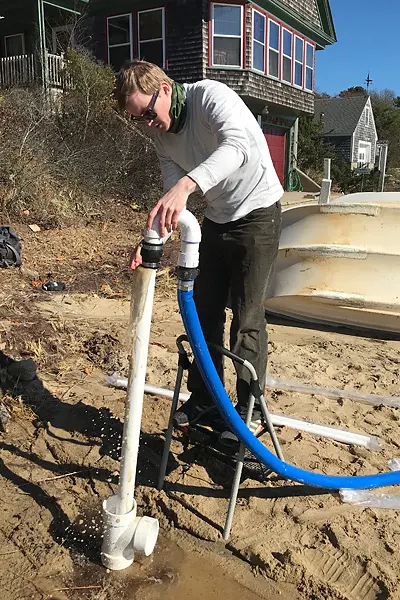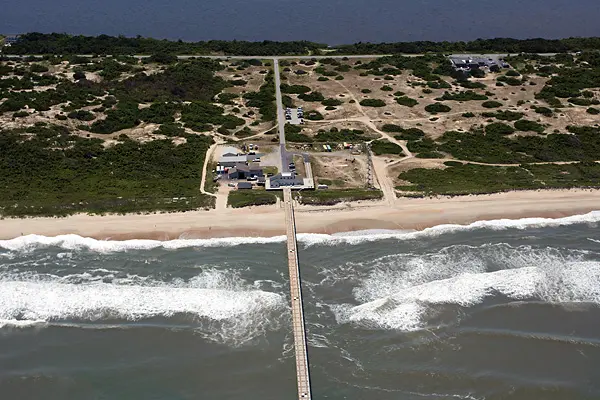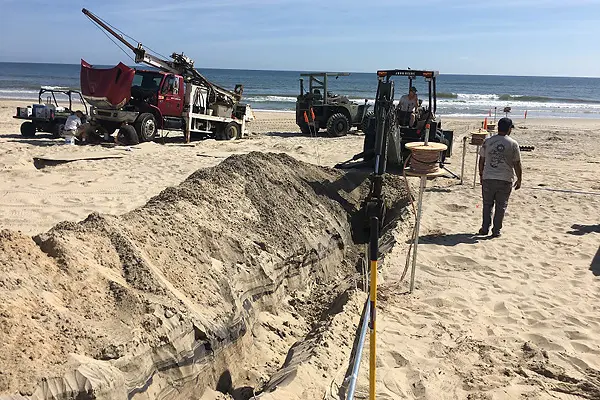Funding Will Support Research into Water and Chemical Exchanges along Estuaries

Asst. Prof. James Heiss uses jets of water at high pressure to drill a sampling well into a beach.
01/31/2022
By Edwin L. Aguirre
The National Science Foundation (NSF) has awarded Asst. Prof. James Heiss of the Department of Environmental, Earth and Atmospheric Sciences a five-year, $680,000 faculty early-career development award for his research into understanding water and chemical exchanges between groundwater and surface water along the transition zone between land and sea.
Called the CAREER award, the highly competitive annual program selects the nation’s best young university scholars who, according to the NSF, “most effectively integrate research and education within the context of the mission of their organization.”
Heiss, who joined UMass Lowell in 2018, will use the CAREER award to pursue his research project, “Hydrodynamic Controls on Fluid and Solute Exchanges Across the Aquifer-Estuary Interface.”
Heiss will study three sites: the Merrimack River estuary, the Delaware Bay estuary and the Chesapeake Bay estuary. Knowledge gleaned from this research can be used to help protect river and marine ecosystems and habitats.
“This study focuses on the role of tides, currents and differences in fluid density between seawater and freshwater in estuaries in driving the movement of water and dissolved chemicals across the sediment-water interface,” he says.
According to Heiss, estuarine waters can have excess levels of nutrients, such as nitrogen in the form of nitrate, from fertilizer runoff. The water and nutrients are pushed into the seabed by tides and currents before cycling back into the estuary. While cycling through the sediments in groundwater, the nutrients can be chemically removed before re-entering the estuary. Otherwise, the excess nutrients could contribute to algal blooms, which could result in beach closures.
 Image by ERDC
Image by ERDC
Heiss says previous studies have measured or modeled water and chemical exchanges across riverbeds and in the coastal ocean, but little is known about the volumes and patterns of the flow of groundwater across the sediment-water interface in estuaries that connect land and coastal ocean systems.
“In estuaries, tides propagate inland, currents shift landward and seaward, and rising sea levels create a hydrodynamically complex and challenging environment to study hydrogeology,” says Heiss. “Our goal is to better understand the flow of groundwater and the biogeochemical reactions that take place in aquifers beneath different types of estuaries. This would help to bridge our understanding of fluid exchanges below the sea to exchanges across riverbeds.”
The outcome of the research could, he says, improve water-quality models and forecasts, thereby helping reduce human and marine life exposure to coastal pollutants.
Heiss also notes that insight into the rates of saltwater intrusion into aquifers beneath and adjacent to estuaries can be used to guide the placement of pumping wells, which will improve management of water resources.
“This is important because 21 of the world’s 30 largest cities are located next to estuaries,” he says.
An Introduction to Hydrogeology
As part of the CAREER grant’s educational outreach, Heiss and the Department of Environmental, Earth and Atmospheric Sciences are planning to offer a new hands-on course to teach students about the role of groundwater in the hydrologic cycle and introduce them to field and laboratory methods in hydrogeology.

He will use a portion of his grant to engage UMass Lowell undergraduate and graduate students as well as Lowell High School students in a new outdoor, hands-on learning facility, called the Merrimack River Hydrogeology Instructional Lab, where three groundwater wells will be installed along the riverbanks on South Campus.
“Middle school students will also learn about saltwater intrusion at a second instructional field site located closer to the ocean,” Heiss says. As part of the project, he will be working with Mass Audubon’s Joppa Flats Education Center in Newburyport, Massachusetts.
Studying the Impact of Coastal Storms on Beach Aquifers
In 2020, the NSF awarded Heiss and the Woods Hole Oceanographic Institution a three-year, $784,000 grant to study how powerful coastal storms affect fresh water flowing below the ground in beach aquifers along the seashore.
Last August, Heiss and his students installed wells and water-quality sensors along the beach at the U.S. Army Engineer Research and Development Center’s Field Research Facility in Duck, North Carolina.
“Our field experiment is still ongoing,” says Heiss. “The wells and instruments survived crashing waves from some big storms that moved up along the East Coast last hurricane season, so we are excited to start looking at the data.”
